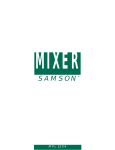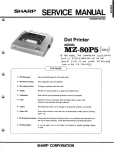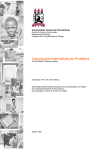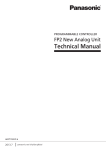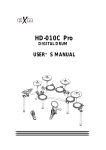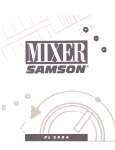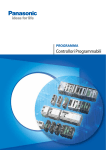Download Yamaha DMR8 v.3.0 Technical information
Transcript
Yamaha DMR8 Digital Recorder/Mixer A User Report from Mike Collins: Yamaha brought out their first digital MIDI-controllable mixer, the DMP7 about three years ago. They followed this up with a digital in/out version, the DMP7D a year or so later. This year, in what could be viewed as a logical progression, they have launched the DMR8, an integrated all-digital system for both mixing and recording. This combines an 8-track digital recorder, a digital mixer, a locator, three effects processors, and mixing automation all in one box! Other recent additions to the family include the DMC1000 mixer, the SPX1000 effects processor, and the DEQ7 digital EQ processor, while older members of the family include the DMP7, DMP11, and DMP7D sub-mixers. Yamaha are aiming the DMR8 at professional musicians, composers, and arrangers working on commercial music production, and have priced the unit at around the twenty grand mark for the basic system. You do need to get either a two channel or an eight channel analogue input unit to provide A/D conversion, and this will set you back another grand or three, depending on how many inputs you need. And, if necessary, yet another thousand pounds will buy you an 8-channel phantom power unit, the HA8, to complete a basic system. The idea is that, with this system, an artist could produce a master recording in a home studio to the very highest audio standards, with a relatively affordable outlay for the equipment. Yamaha anticipate that the artist might record tracks at home and then bring a DMR8 tape into a studio and transfer the tracks digitally to a larger digital multitrack system. Or a composer might send a DMR8 multitrack tape to a video production facility or broadcast studio for further mixing or processing. To keep Studio Sound readers informed about this interesting new system, I spoke to a fairly representative selection of both dealers and end-users and I will present their comments here first. Yamaha supplied me with a DMR8 for several weeks to evaluate in my home studio, so I will carry on to relate how the system works in practice. Finally, I will present an overview of the main features for those of you who may be interested to read in a little more depth about the DMR8's capabilities. Comments: Rob Ferguson from Thatched Cottage Digital (TCD): "The quality of the mixer is untouchable, but a working system will cost you £25,000. This may seem expensive compared with other products coming out, such as the Alessis and the Roland Hard disk stuff, but these systems don't include the built-in digital mixer and effects. It's a great system for wealthy producers and musicians, such as Dave Stewart who is hawking a DMR8 between his three studios in LA, Cannes, and London. He is using currently it for his on-location film soundtrack work, apparently." According to Rob, Pete Townsend put the DMR8's operational features into a certain perspective when Alan Martin (Digital Audio Product Specialist) from Yamaha was explaining in a very succint technical way about how to operate the machine. "We went to Pete Townsend's place, and while Alan was in the middle of his 'spiel' about how to work the machine, Pete asked how he would get the thing working quickly if he stumbled down to his studio late at night, stoned perhaps, but with a 'hot' musical idea!" A fair question which deserves a fair answer, I thought! The DMR8 is a very powerful device with a myriad of features, and it is obviously going to take anyone new to the system quite some time to become completely conversant with it. However, Yamaha have made it very easy to get set up to record by providing standard configurations for different types of recording session, stored in memory. You can just call up one of these and customise it as necessary for your particular session. So probably the best answer to Pete's question is that you could set the DMR8 up the way you would like it to be at any particular time, and then hit a couple of buttons to recall this setup whenever you like very simple, as long as you can still see straight enough to hit the buttons! Kevin De Souza of School House Studio: School House is a newly-built MIDI studio near Farringdon in the City of London. Studio Engineer Kevin De Souza told me that they use 2 DRU8's, bought from TCD, in conjunction with a DDA DMR12 analogue mixer. "The sound of the DRU8's is startlingly good, and I think they sound even better used with the DDA console and the typical outboard effects which we use, such as Lexicon reverbs, Eventide harmonizers, and so forth. These bring so much character into the sounds, compared with the the SPX1000 type effects in the DMR8. We did consider going for the DMR8's because of the automation, but we felt it was too limiting to have to get so many extra a/d converters, or to be prevented from hooking up analogue gear, Pultec's or whatever. We can still do a lot of work totally digitally, using Sound Tools. We have tried A/B'ing audio recorded simultaneously into the DRU8 and Sound Tools. With guitar parts, for instance, the sound from the DRU8 just 'comes out of nowhere', whereas with Sound Tools you can hear the noise floor if you turn it up enough. When you record into Sound Tools you have to record very carefully using limiters and so forth, so it is much better for editing stuff recorded on other machines like the DRU8. I was very impressed with the way the DRU8's stood up to the heat this summer, before we had our air-conditioning fitted - I am sure I would have had problems with lesser machines. One of the beauties of the system is the no-loss bounce-down capabilities of the DRU8. And you don't need any free tracks to bounce to, as they can be bounced to themselves! By having a split system (two DRU8's) and having the digital cascade between the two, you can achieve an amazing degree of flexibility. On another 'note', some of the remixers we work with are putting two stereo masters onto 4 tracks of the DRU8 so they can switch easily between the two, or even run both together. This is not something we anticipated using the DRU8's for, but it works great in practice!" Jonathan Cole from TSC: "We believe that there is a small but significant market for this system, which we have geared up to serve. We have sold about eight systems to date, to clients including George Michael, Dave Stewart, INXS, Mark Saunders/The Mission, Martin Levan Sound/Joseph & The Amazing Technicolour Dreamcoat," John Spinks/The Outfield, and I can't remember the rest. We now have eight very happy clients - and, touch wood, we haven't had a single problem with any of them so far. That for me is the most important thing about the DMR8 - its reliability. It is the only machine of its kind with an integrated mixing console, so taking this into consideration, it is probably the chepest available. It certainly sounds the best!" Junie Morrison: Junie Morrison (ex-Parliament/Funkadelic) recently bought a DMR8 system from TCD. Junie has a production-based company in North-West London and is very busy producing a range of acts, including Mica Paris, Yazz, and others. "The way I survived was to toss everything I knew about consoles away. Once I got used to the new console it was OK. It was weird in the beginning, but I had very good support both from Rob at Thatched Cottage and from Alan Martin at Yamaha. The DMR8 does take quite a bit of getting used to. I had one on loan for a few weeks, and it took this length of time to get familiar with the basic functions. It was exciting at the same time, and once I acquired the machine, it took me about 30 days to become really comfortable with it. I still get occasional lapses as to where a particular button or function is. You do have to get more used to working with the screen rather than having manual contact with everything as on an analogue desk." Yamaha Product Specialist Alan Martin: "They have now been out in the field for six and a half months, and we haven't had a single fault that was not a simple thing such as a dodgy connector!" User Report: I received the DMR8 for review the day before starting a new recording project in my home studio. This project was to create a fresh arrangement of a song and to demo it to a high standard using MIDI equipment - with 'live' guitars and vocals. This seemed an ideal project to use to put the DMR8 through its paces. The beauty of using the DMR8 would be that if we managed to capture some 'magic' vocals or guitar parts, and the artist wanted to go on and master the track for release, we could simply get a DMR8 into the mastering studio, and finish the recording off without the hassle of trying to recreate the 'magic' parts at much greater expense and under pressure. Yamaha originally supplied me with an AD8X 8-channel A/D converter which has +4 dBm XLR inputs. I quickly realised that most of my equipment would not provide high enough output levels without putting signals through a channel of my analogue desk and taking a direct line level output to the AD8X. So Yamaha sent me an HA8 microphone pre-amplifier. The problem here was that there were only balanced XLR microphone inputs, and that each channel needed a short XLR to XLR connector to hook its +4 dBm output into the appropriate AD8X input - and I didn't have the correct cables available. Another call to Yamaha sorted this out. The next problem which surfaced was pure bad luck - two of the record tracks on this particular DMR8 were faulty, and produced a series of loud cracking sounds when I attempted to replay material which appeared to have recorded OK. A quick check using the C2 error flag display confirmed that there were problems on these two channels, and a check of the Head On Time showed that this machine had been used for a total of 25 hours since it left the factory. These two displays which proved to be so useful at this point were readily available from the Help Menu on the DMR8. Yamaha were very good about this problem, and arranged to bring me a replacement DMR8 the very next day. I decided to record most of the MIDI instrument data into a Macintosh II computer running Performer MIDI sequencer. Once this was done, I took a cable from the DMR8's dedicated MIDI Time Code DIN socket to the Macintosh, and put the Mac in external MTC sync mode. I had to format a DMR8 tape cassette before I could use it, which took one 20-minute pass, as I decided to format the whole tape at the outset. During this process, SMPTE timecode was generated by the DMR8 and recorded onto a special track for this purpose. Once this was done, I just had to choose a SMPTE start time in the Macintosh, and everything synced up straight away. The next problem surfaced when I was rolling the tape back - I heard various bits of MIDI gear 'firing off' in bursts as the tape rewound. This became a major annoyance as I worked on the MIDI recording, and I became very adept at switching the sequencer out of sync while rewinding the DMR8. I enquired about this at Yamaha R & D, and was told that it was due to bursts of MIDI Time Code being sent from the dedicated MTC output and intended to keep slave tape machines in sync with the DMR8 master. They have now realised themselves that this is not ideal when syncing to MIDI equipment, and there is a possibility that future versions of the DMR8 will let you switch these MTC bursts off or on as needed. It does seem a little remiss of the designers not to have considered this usage of the DMR8 with an external sequencer at the original design stage, however! Once everything was set up properly, and I started to get more familiar with the DMR8, which all took about a week, things then started to run much more smoothly. I worked mostly in Sync Overdub mode at first, as I was recording guitars and vocals to the multitrack while monitoring my MIDI gear which was playing back through my Teac analogue mixer. Once I had the guitars and a guide vocal on tape, I wanted to set everything up as it would sound in a mix, but still be able to drop into record new tracks at any time. Unfortunately, the EQ and effects sends don't work in Sync Overdub mode while you are monitoring tracks off tape. These only work in Mixdown mode, and I couldn't work in this mode and drop in to record at a moment's notice. I remember working on various analogue consoles which also had this limitation, but I would have expected the DMR8 to provide this kind of flexibility as a matter of course. It quickly became obvious to me that I really needed about four DMP11 submixers to take the separate outputs from my samplers and synthesizers. Using the digital cascade connections, I could have submixed all my MIDI gear using the DMP11s and brought them into my DMR8 mixes alongside the eight tracks coming off tape. I would then have had eight extra mixer channel inputs available in mixdown mode on the DMR8 via the existing HA8/AD8X. I could have used these to hook up a couple of extra synths and a drum machine which another musician had brought in for the session. To use the third set of eight mixing channels on the DMR8, I would have needed either a second HA8/AD8X combination, or a DRU8 - the stand-alone recorder section, which would have provided an extra eight recording tracks. As it was, I had to feed the analogue control room monitor outputs from the DMR8 into my Teac mixer, and balance these with my MIDI gear, before mixing to DAT from the Teac console. Automation: The DMR8 has three 'current' automix memories, and eight 'data' memories. Any one of these can be replayed at any time. Memories can also be moved or copied from one location to another, and can be appended to each other to allow assembly of a mix from separate sections. The data memories can be stored to the Table Of Contents part of the tape, or to a memory card. Alternatively, they can be sent via MIDI System Exclusive into a sequencer or other software, and from there onto a computer disk. Data is written into the current memories initially, and these are organised in a last in first out fashion, such that you write your first pass into current memory 1. On your next pass, this data is moved into current memory 2, and memory 1 takes the new data. On the next pass, what was in memory 2 moves into memory 3, while new data is written to 1; so on subsequent passes, the data from memory 3 will be lost as it is over-written from memory 2 each pass. The idea is that you can quickly record a number of passes through your mix into the current memories, and then save the ones you want to the data memories. Up to three data areas may be merged into another data area, so, for instance, mutes from one pass can be merged with fader movements from another. I used the most basic of the automation features - the channel fader automation - to 'ride' the levels of the vocal and guitar parts during one of my mix sessions. This was extremely simple to set up and use: you just press the Auto Mix Edit button, make sure the cursor is on Record, and that Record is activated (using the nearby left/right, up/down arrow keys), and then press Play on the transport controls. Now, when you move any mixer control, this change will be recorded into current memory 1. When you stop the tape, the display prompts you to select whether to keep your mix or not. To play your mix back: you press Auto Mix Edit again; select and enable Play this time; press the Shift Next key to access a display which allows you to choose which mix memory to replay; choose Absolute or Follow mode, and Continue or Return mode, and then hit Play on the transport controls. In Absolute mode, the fader movements are recorded exactly, and in Follow mode the relative movements of faders are added to the existing data. In Continue mode, the last setting of any edited mix data will continue until a change occurs in the original data which will reset the parameter. In Return Back mode, as soon as the edited data finishes, the parameter returns back to the original setting. This can produce a sudden, unwanted, fader level change, for instance, so the Continue mode is probably the one to use in most circumstances. The default settings are Absolute and Continue, so you can skip over these without having to make any adjustments most of the time. Obviously, you do have to take the trouble to become familiar with several new concepts like these, which you probably have not encountered on other mixers. Still - there is nothing mind-bogglingly difficult about the DMR8 - it's just a matter of spending some time with the machine to get to know it. The automation facilities provide very sophisticated control over the DMR8's many control functions, and I am sure that users who take the trouble to explore the automation fully will be rewarded with an excellent aid to their creativity. More Automation: There are four sets of 'snapshot' memories, accessible from buttons labeled F1 to F4. The F1 bank of memories is used to store a complete snapshot of all the DMR8 settings. Memories 1 to 16 are used when recording, and memories 17 to 32 are used when mixing. The F2 bank has 32 memories and can be used to store various groups of mixer settings, such as EQ, pans, or effects. The F3 bank can store further user-defined parameters, such as track and channel names. The F4 bank is used to store timecode locations that can be used with the autolocator. More interestingly, these timecode locations can be used in conjunction with the Event Edit facility to change the mixer settings automatically to other memory settings held in the F1 to F3 banks at specified timecode locations, providing an alternative method of mixer automation (though you cannot use both methods simultaneously). Memories are automatically stored onto a RAM card which is supplied with the unit, and Yamaha can supply extra cards as required. You normally switch through the memories using up/down arrow keys in conjunction with a Recall button, but there are also eight dedicated memory keys to which you can assign a selection of eight memories of your choice when recording or mixing - for extra convenience. The memories may also be recalled using MIDI Patch Change messages, which provides for a third method of mixer automation - obviously very useful for working with MIDI sequencers. Mastering to DAT: When it came to supplying the client with a DAT master of the track, the DMR8 allowed me to choose whether to create a DAT master which would allow no digital copies to be made, or just one copy, or unlimited copies. This is ability to set the copy-prohibit flag (on a DAT 2-track master mixed from the DMR8) according to your needs is obviously a very convenient feature for studio users. Standard S/PDIF phono connectors are available for connection to DAT recorders. Overview: The Mixer: The mixer section can be set up either for eight input, eight bus recording, or for twentyfour input, stereo output operation in mixdown mode. There are only eight sets of channel controls available on the console, but these can be assigned via the software to control three banks of eight channels (1-8, 9-16, or 17-24) to provide the twentyfour remix channels. I think that this is a very acceptable way to implement a large number of channels in a relatively small unit like this. On the other hand, the two green LCD display units, although workable, are a bit on the small side. Yamaha have made provision to connect a larger VDU so that you can see many more parameters at one time. You could alternatively hook up to a personal computer via an RS422 interface provided for this purpose, but you would need suitable control software. Or you could control some of the DMR8 parameters remotely using MIDI, although you would probably run out of MIDI bandwidth if you tried to control everything this way. All the faders are motorised, like on the DMP7, and there are 11 faders in all. In the normal 'channel' mode, the first 8 act as channel level controls, the 9th acts as a stereo sub-input fader, and the 10th controls the master control room level. These faders can also be assigned via the software to control various other functions, such as the EQs. The stereo sub-input fader lets you connect a Yamaha DMP7 mixer to provide even more inputs, if needed. As on the DMP7-series mixers, you can quickly 'flip' the faders to a 'send' mode so that faders 1-8 would be effects sends, 9 would be the stereo effects return, and 10 would be the master send level. Finally, an 11th fader is provided just for data entry. Each mixer channel includes a Pan control, 3-band parametric EQ, and three effects sends to the main effects units. In addition, each channel has its own independent effects, including a basic compressor/limiter and delay effects. These channel effects are typically used to process signal before they are recorded to tape. The three main effects units are similar to the SPX1000, and provide good reverbs, ambience, delay, pitch change and other effects. The three stereo effects returns for these all have 3-band parametric EQ. These effects are available for use in Mixdown mode. The digital control features allow the console to be reconfigured to suit any recording or remix situation at the touch of a button, and several preset configurations are available to suit most common setups. The faders can be programmed to provide very fine resolution, and subgrouping facilities are also available. All these features are very well thought-out, and most engineers will quickly appreciate the capabilities of the DMR8. The Recorder: The stationary-head 8-track digital recorder (which is also available separately as a stand-alone unit, the DRU8) uses a special Yamaha metal particle tape cassette. This recorder has eight digital PCM audio tracks, two auxiliary analogue tracks, a timecode track and a control track. The DMR8 is the first multitrack recorder to store digital audio on tape as 20-bit data, providing an amazing 120 dB of dynamic range. This should enable the user to allow plenty of headroom when setting recording levels, and still achieve sensible signal levels. If you use the highest sampling rate of 48kHz, the standard cassette provides 20 minutes of 8-track audio, which is more than enough for most projects, but could prove to be a limitation if you wanted to work on very long compositions, or on an album. It is unfortunate in some ways that Yamaha have chosen to use a non-standard cassette for this system, and some prospective users may be put off by this. However, Yamaha have done an amazing job in designing such a high-quality working digital multitrack using such a small cassette - and you can save on both tape costs and storage space compared with analogue tapes. If you need more tracks or more recording time, you can achieve either of these by hooking up a DRU8 recorder. This can be configured so that you get either sixteen tracks to play with, or double the recording time (to 40 minutes) with eight tracks. For longer times or even more tracks, further DRU8 units can be linked in, which does make for a pretty versatile situation. Synchronization: The DMR8 has comprehensive synchronization capabilities, including all SMPTE TimeCode formats, jam-sync, MIDI Time Code, MIDI Clock, and MIDI Song Position Pointers. There is also a V-Sync input for use with composite digital video tape recorders. In addition, there are cue list and editing procedures using control signals which conform to Sony protocols, for use with equipment which uses these. These facilities ensure that the unit can be used straight away in a variety of professional recording situations, especially when working to picture, with a minimum of external equipment. Analogue I/O: The DMR8 offers analogue Control Room Monitor and Cue Monitor outputs for your monitor loudspeakers and headphones, as well as a two-channel analogue input to allow you to connect an analogue tape or cassette machine. You cannot insert analogue effects into the program chain, unfortunately. This means that you can't hook up your favourite AMS reverb or PCM70 effects unit to process channels within the DMR8. However, there is no problem hooking in effects units (such as Yamaha's SPX1000) which do have digital inputs/outputs - and more such devices will feature digital I/O as time goes on. Goodies: If a composite video signal is fed out of the Video Out connector on the rear panel, the current SMPTE time will always be displayed on the video monitor. In addition, anything on the DMR8 sub-display will also be displayed on the monitor. Obviously these are very useful features when working to picture. Another important feature for me is the ability to store all the memory data and automation data, along with session notes, to the Table Of Contents part of the actual tape. You can also store this information onto memory cards. There are various note 'pages' available to hold technical information (such as timecode type, sampling frequency, etc), credits (producer, engineer, etc), 'Artists' notes, and general 'Session' notes. The TOC notes and automix data are recorded onto the first 20 seconds of two tracks of the tapes. If more sets of data are needed, additional tracks may be used. It is a very sensible move to let the engineer store this information on the actual tape, as it is all too easy for extra disks to be mislaid or damaged in real life. The MIDI facilities are very comprehensive too. You can dump most types of data to a computer or other MIDI data recorder via SysEx; use SysEx data for remote control of DMR8 parameter changes; use MIDI program Change messages to recall memory data; or use MIDI Control Change data to remotely control the DMR8 control settings. Using MIDI Controllers, you could quantize and synchronize fader movements to musical events, for instance. You can also transmit MIDI Note On and Off messages from any timecode locations, and you would typically use this feature to trigger sound effects from samplers. Conclusions: One of the main areas in which the DMR8 scores is in the way that it keeps everything in the digital domain until you finally need to play back via an analogue system. This also makes it possible for the DMR8 to offer one of the first true 'total recall' systems. From mix parameters, including EQ, level, and mute settings, to total recall of effects parameters, to the final recorded audio data - everything can be automated. Also, the compromise of having only eight sets of channel controls, but making these assignable to twentyfour channels via software for mixdown, works out very well - especially in situations where there is not too much space, or where you need to have other equipment in front of you such as Video monitors, computers, or MIDI keyboards. In practice, I found the machine to be quite easy to learn, and the sound quality to be first rate. I do like the versatile SPX1000-type effects, but I also used various other outboard effects by putting them in-line with the analogue signal from whatever instrument I wished to use them with, and recording the original signal plus effects to tape. I did miss the flexibility of being able to use any external analogue effects on mixdown, but I still got good results with the built-in effects. For use in a MIDI studio, I would suggest that you use DMP7/11 submixers for most of your MIDI gear, and have just one AD8X/HA8 combination for bringing audio directly into the DMR8. So did I like it? The answer here is a resounding "Yes!" The quality of the vocal and guitar recordings which I made were higher than anything I have recorded previously in my home studio, and it really was like having a professional recording studio 'in a box'. I am seriously thinking of investing in four or five DMP11's and maybe a DMP7D, and, in the longer term, trading in my analogue mixer and 8-track recorder for a DMR8, or possible for a DMC1000 and a multitrack hard disk recorder! The DMR8 should appeal to its 'target-audience' of top professional composers and musicians for all the reasons I liked it, and for such people the price is certainly affordable for the range of facilities on offer. You may be tempted to think of the DMR8 as a "rich man's Portastudio", which it certainly is. But it is much more than this, as well! I believe that it will find many niches in audio-visual studios and MIDI programming suites, or even for 'live' performances which are increasingly involving MIDI equipment. It certainly shows off the exciting new directions in which the digital technology is heading! Mike Collins © August 1991









